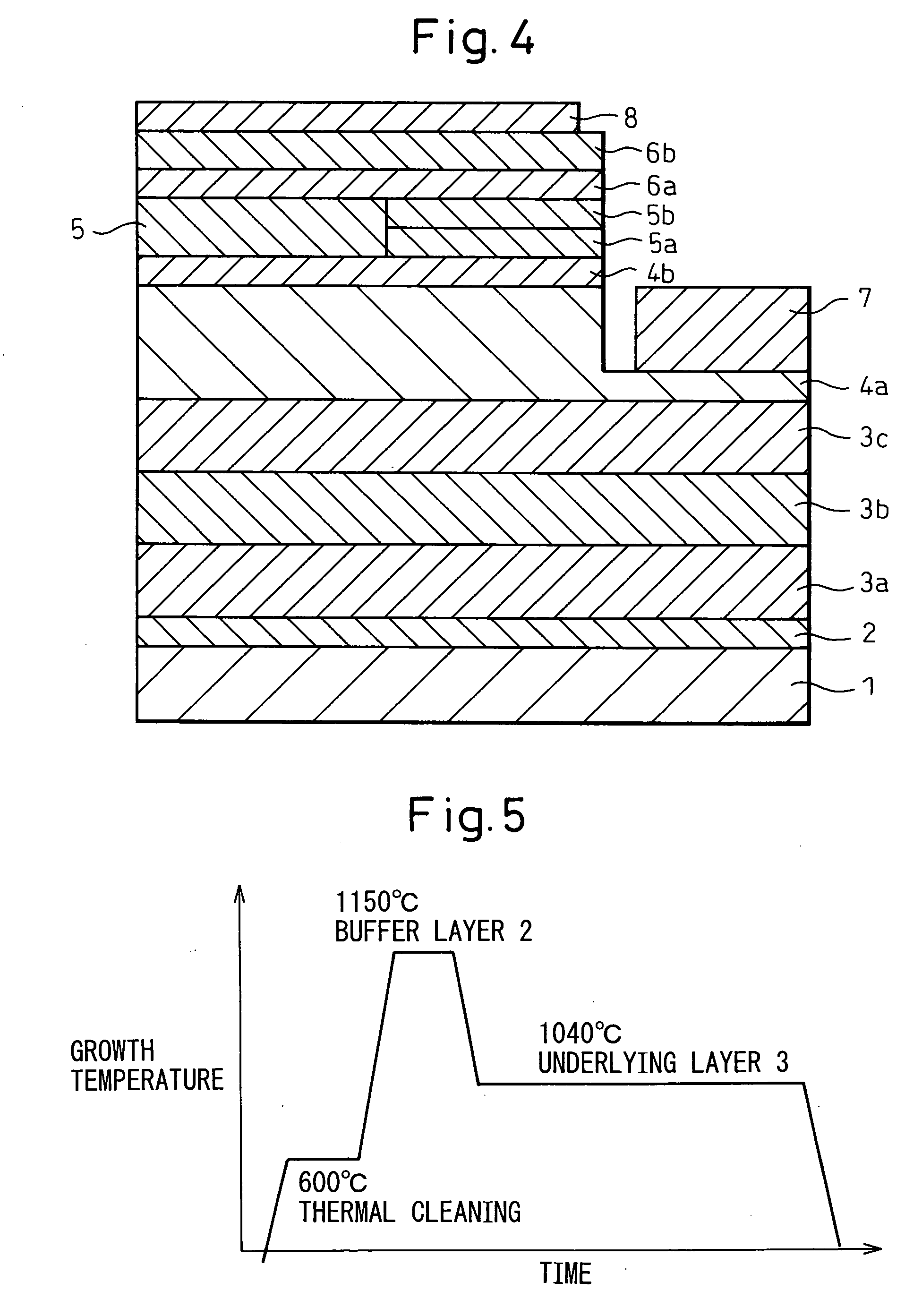Group III nitride semiconductor stacked structure and production method thereof
a technology of stacked structure and nitride, which is applied in the direction of semiconductor/solid-state device manufacturing, semiconductor devices, electrical devices, etc., can solve the problems of difficult growth of single crystals, inability to obtain satisfactory crystallinity, and difficulty in growing single crystals, etc., to achieve high-efficiency light-emitting devices and low cost
- Summary
- Abstract
- Description
- Claims
- Application Information
AI Technical Summary
Benefits of technology
Problems solved by technology
Method used
Image
Examples
example 1
[0075]FIG. 2 is a schematic drawing showing a cross-section of a group III nitride semiconductor stacked structure produced in the present example, while FIG. 3 is a graph showing the temperature profile of each step in the present example. The aforementioned structure was formed in the order indicated below using a typical reduced-pressure MOCVD. First, an R-plane sapphire substrate 1 was placed on a high-purity graphite semiconductor susceptor heated to a growth temperature with a radio-frequency (RF) induction heater. After placing the substrate on the susceptor, nitrogen gas was introduced into a stainless steel vapor phase growth reactor to purge the inside of the reactor.
[0076] After circulating nitrogen gas through the vapor phase growth reactor for 8 minutes, the induction heater was activated to raise the temperature of the substrate 1 from room temperature to 600° C. over a period of 10 minutes. Hydrogen gas and nitrogen gas were then circulated through while maintaining ...
example 2
[0086] A group III nitride semiconductor layer was additionally stacked onto the stacked structure produced in Example 1 to produce a group III nitride semiconductor light-emitting device. FIG. 4 is a drawing schematically showing the cross-sectional structure of the group III nitride semiconductor light-emitting device produced in this example.
[0087] After producing the device through the third underlying layer 3c by repeating the procedure described in Example 1, an n-type contact layer 4a composed of Si-doped n-type GaN was formed. After stacking the n-type contact layer 4a, an n-type clad layer 4b composed of Si-doped n-type In0.03Ga0.97N was stacked at 730° C. This n-type clad layer 4b was grown to a layer thickness of 12.5 nm using triethyl gallium (TEG) for the gallium source and trimethyl indium (TMI) for the indium source.
[0088] Next, a multi-quantum well structure light-emitting layer 5 having a pentacyclic structure, composed of a barrier layer 5a composed of GaN and a ...
PUM
| Property | Measurement | Unit |
|---|---|---|
| thickness | aaaaa | aaaaa |
| temperature | aaaaa | aaaaa |
| temperature | aaaaa | aaaaa |
Abstract
Description
Claims
Application Information
 Login to View More
Login to View More - R&D
- Intellectual Property
- Life Sciences
- Materials
- Tech Scout
- Unparalleled Data Quality
- Higher Quality Content
- 60% Fewer Hallucinations
Browse by: Latest US Patents, China's latest patents, Technical Efficacy Thesaurus, Application Domain, Technology Topic, Popular Technical Reports.
© 2025 PatSnap. All rights reserved.Legal|Privacy policy|Modern Slavery Act Transparency Statement|Sitemap|About US| Contact US: help@patsnap.com



